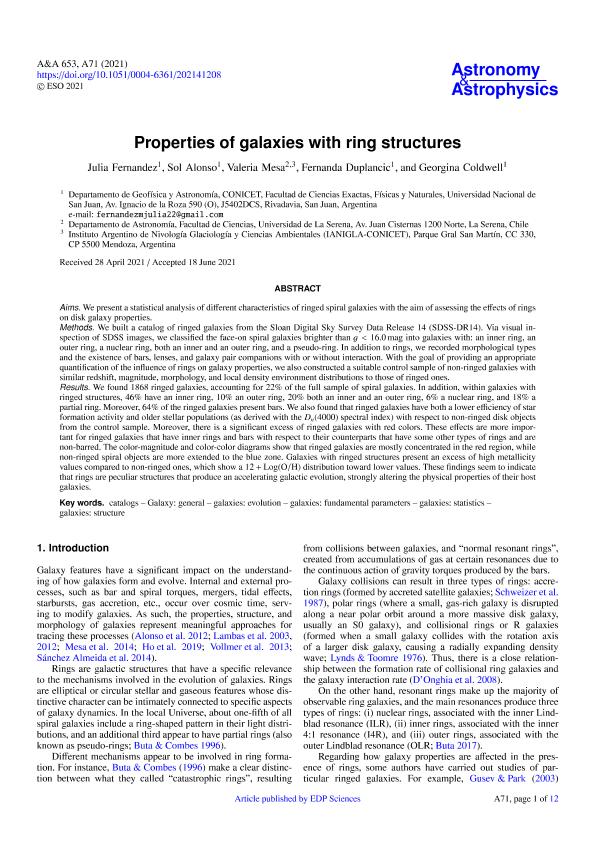Mostrar el registro sencillo del ítem
dc.contributor.author
Fernandez, Julia
dc.contributor.author
Alonso, Sol
dc.contributor.author
Mesa, Valeria Alejandra

dc.contributor.author
Duplancic Videla, Maria Fernanda

dc.contributor.author
Coldwell Lloveras, Georgina Vanesa

dc.date.available
2022-05-26T19:59:43Z
dc.date.issued
2021-09
dc.identifier.citation
Fernandez, Julia; Alonso, Sol; Mesa, Valeria Alejandra; Duplancic Videla, Maria Fernanda; Coldwell Lloveras, Georgina Vanesa; Properties of galaxies with ring structures; EDP Sciences; Astronomy and Astrophysics; 653; 9-2021; 1-12
dc.identifier.issn
0004-6361
dc.identifier.uri
http://hdl.handle.net/11336/158255
dc.description.abstract
Aims: We present a statistical analysis of different characteristics of ringed spiral galaxies with the aim of assessing the effects of rings on disk galaxy properties. Methods: We built a catalog of ringed galaxies from the Sloan Digital Sky Survey Data Release 14 (SDSS-DR14). Via visual inspection of SDSS images, we classified the face-on spiral galaxies brighter than g < 16.0 mag into galaxies with: an inner ring, an outer ring, a nuclear ring, both an inner and an outer ring, and a pseudo-ring. In addition to rings, we recorded morphological types and the existence of bars, lenses, and galaxy pair companions with or without interaction. With the goal of providing an appropriate quantification of the influence of rings on galaxy properties, we also constructed a suitable control sample of non-ringed galaxies with similar redshift, magnitude, morphology, and local density environment distributions to those of ringed ones. Results: We found 1868 ringed galaxies, accounting for 22% of the full sample of spiral galaxies. In addition, within galaxies with ringed structures, 46% have an inner ring, 10% an outer ring, 20% both an inner and an outer ring, 6% a nuclear ring, and 18% a partial ring. Moreover, 64% of the ringed galaxies present bars. We also found that ringed galaxies have both a lower efficiency of star formation activity and older stellar populations (as derived with the Dn(4000) spectral index) with respect to non-ringed disk objects from the control sample. Moreover, there is a significant excess of ringed galaxies with red colors. These effects are more important for ringed galaxies that have inner rings and bars with respect to their counterparts that have some other types of rings and are non-barred. The color-magnitude and color-color diagrams show that ringed galaxies are mostly concentrated in the red region, while non-ringed spiral objects are more extended to the blue zone. Galaxies with ringed structures present an excess of high metallicity values compared to non-ringed ones, which show a 12 + Log(O/H) distribution toward lower values. These findings seem to indicate that rings are peculiar structures that produce an accelerating galactic evolution, strongly altering the physical properties of their host galaxies.
dc.format
application/pdf
dc.language.iso
eng
dc.publisher
EDP Sciences

dc.rights
info:eu-repo/semantics/openAccess
dc.rights.uri
https://creativecommons.org/licenses/by/2.5/ar/
dc.subject
CATALOGS
dc.subject
GALAXIES: EVOLUTION
dc.subject
GALAXIES: FUNDAMENTAL PARAMETERS
dc.subject
GALAXIES: STATISTICS
dc.subject
GALAXIES: STRUCTURE
dc.subject
GALAXY: GENERAL
dc.subject.classification
Astronomía

dc.subject.classification
Ciencias Físicas

dc.subject.classification
CIENCIAS NATURALES Y EXACTAS

dc.title
Properties of galaxies with ring structures
dc.type
info:eu-repo/semantics/article
dc.type
info:ar-repo/semantics/artículo
dc.type
info:eu-repo/semantics/publishedVersion
dc.date.updated
2022-05-20T12:54:08Z
dc.journal.volume
653
dc.journal.pagination
1-12
dc.journal.pais
Francia

dc.journal.ciudad
Les Ulis
dc.description.fil
Fil: Fernandez, Julia. Universidad Nacional de San Juan. Facultad de Ciencias Exactas, Físicas y Naturales. Departamento de Geofísica y Astronomía; Argentina
dc.description.fil
Fil: Alonso, Sol. Universidad Nacional de San Juan. Facultad de Ciencias Exactas, Físicas y Naturales. Departamento de Geofísica y Astronomía; Argentina
dc.description.fil
Fil: Mesa, Valeria Alejandra. Consejo Nacional de Investigaciones Científicas y Técnicas. Centro Científico Tecnológico Conicet - Mendoza. Instituto Argentino de Nivología, Glaciología y Ciencias Ambientales. Provincia de Mendoza. Instituto Argentino de Nivología, Glaciología y Ciencias Ambientales. Universidad Nacional de Cuyo. Instituto Argentino de Nivología, Glaciología y Ciencias Ambientales; Argentina. Universidad de La Serena; Chile
dc.description.fil
Fil: Duplancic Videla, Maria Fernanda. Consejo Nacional de Investigaciones Científicas y Técnicas. Centro Científico Tecnológico Conicet - San Juan; Argentina. Universidad Nacional de San Juan. Facultad de Ciencias Exactas, Físicas y Naturales. Departamento de Geofísica y Astronomía; Argentina
dc.description.fil
Fil: Coldwell Lloveras, Georgina Vanesa. Consejo Nacional de Investigaciones Científicas y Técnicas. Centro Científico Tecnológico Conicet - San Juan; Argentina. Universidad Nacional de San Juan. Facultad de Ciencias Exactas, Físicas y Naturales. Departamento de Geofísica y Astronomía; Argentina
dc.journal.title
Astronomy and Astrophysics

dc.relation.alternativeid
info:eu-repo/semantics/altIdentifier/doi/http://dx.doi.org/10.1051/0004-6361/202141208
dc.relation.alternativeid
info:eu-repo/semantics/altIdentifier/url/https://www.aanda.org/articles/aa/full_html/2021/09/aa41208-21/aa41208-21.html
Archivos asociados
